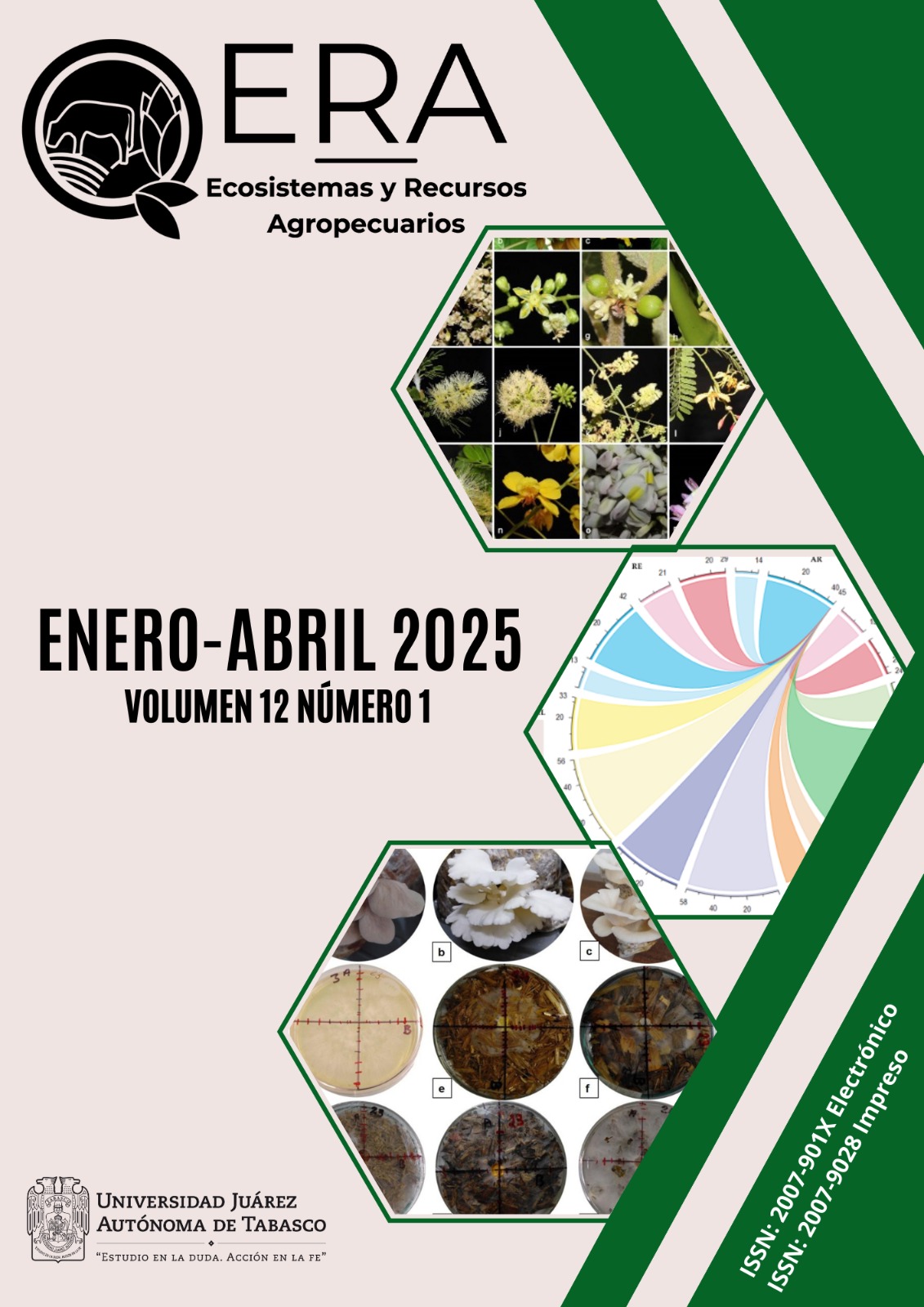Current and future climatic of species of the genus Pinus of Michoacan, Mexico
DOI:
https://doi.org/10.19136/era.a12n1.4030Keywords:
Spatial analysis, Potential distribution, Climate change scenarios, Models of circulation global, Climate nicheAbstract
Climate change scenarios are projections of future climate and evaluate how these modifications have an effect on the composition, structure and distribution of global biodiversity. The objective of this study was to test the hypothesis that climate change projections foresee a substantial reduction in the climatic habitat of 14 species of the genus Pinus in Michoacán, Mexico. Geographic records were obtained for 14 pine species distributed in Michoacán. The 19 current (1970-2000) and future (2041-2060) bioclimatic variables were downloaded from the Global Circulation Models (GCMs) HADGEM3_ES and MPI_ESM_LR with a shared socioeconomic trajectory 245 from WORLDCLIM. The records and variables were loaded into Maxent, where 75% of the records were used to train and 25% to validate the models, which were evaluated using the area under the curve (AUC), partial Roc and Z tests. The results of these tests were excellent (AUC > 0.88, > 1.52, p < 0.01). The most relevant variables for the 14 species were average maximum temperature of the warmest period (Bio5), precipitation of the warmest quarter (Bio18), accumulated annual precipitation (Bio12) and average minimum temperature of the coldest period (Bio6). Based on the results obtained, the hypothesis is accepted, because significant reductions in climatic habitat are expected for 13 of the 14 species, with the species most susceptible to climate change being P. hartwegii, with a reduction in climatic habitat of 42.3%, P. leiophylla (43.5%), P. devoniana (44.2%), P. herrerae (59.7%) and P. martinezii (62.9%).
Downloads
References
Aceves-Rangel LD, Méndez-González J, García-Aranda MA, Nájera-Luna JA (2018) Distribución potencial de 20 especies de pinos en México. Agrociencia 52: 1043-1057.
Brassiolo P, Vicuña S (2023) RED 2023: Cambio climático y biodiversidad: De las bases físicas a la perspectiva económica. Distrito Capital: CAF- banco de desarrollo de América Latina y el Caribe. 79p. https://scioteca.caf.com/handle/123456789/2100. Fecha de consulta: 15 de febrero de 2024.
CONANP-PNUD México (2019) Resumen ejecutivo del Programa de Adaptación al Cambio Climático del Complejo de las ANP Reserva de la Biosfera Pantanos de Centla-Área de Protección de Flora y Fauna Laguna de Términos. Comisión Nacional de Áreas Naturales Protegidas y Programa de las Naciones Unidas para el Desarrollo. Ciudad de México, México. 20p.
Cruz-Cárdenas G, López-Mata L, Silva JT, Bernal-Santana N, Estrada-Godoy F, López-Sandoval JA (2016) Potential distribution model of Pinaceae species under climate change scenarios in Michoacán. Revista Chapingo Serie Ciencias Forestales y del Ambiente 22(2): 135-148. https://doi.org/10.5154/r.rchscfa.2015.06.027
Delgado VP, Rebolledo-Camacho V, Flores-López C, García-Magaña JJ, González A, Piñero D, Vázquez-Lobo, AY (2015) Aproximación molecular para la evaluación genética de áreas productoras de semillas y de conservación en especies del género Pinus. Proyecto CONAFOR-2012-C01-176167.
Elith J, Phillips SJ, Hastie T, Dudík M, Chee YE, Yates CJ (2011) A statistical explanation of MaxEnt for ecologist. Diversity and Distributions 17(1): 43-57. https://doi.org/10.1111/j.1472-4642.2010.00725.x.
Instituto Nacional de Estadística y Geografía (INEGI) (2001) Subprovincias fisiográficas. Conjunto de datos vectoriales fisiográficos. Escala 1:1, 000, 000. Serie I.
Instituto Nacional de Estadística y Geografía (INEGI) (2017) Anuario estadístico y geográfico de Michoacán de Ocampo. Gobierno del estado de Michoacán de Ocampo. Morelia, Michoacán de Ocampo. 726p.
IPCC (2014) Resumen para responsables de políticas. Contribución del grupo de trabajo II al Quinto Informe de Evaluación del Panel Intergubernamental de Expertos sobre el Cambio Climático. En Field CB, Barros VR, Dokken DJ, Mach KJ, Mastrandrea MD, Billir TE, Chatterjee M, Ebi KL, Estrada YO, Genova RC, Girma B, Kissel ES, Levy AN, MacCracken S, Mastrandrea PR, White LL (ed) Cambio climático 2014: Impactos, adaptación y vulnerabilidad. Panel Intergubernamental de Expertos sobre Cambio Climático. Ginebra, Suiza. 34p.
Fernández-Eguiarte A, Zavala-Hidalgo J, Romero-Centeno R, Conde-Álvarez AC, Trejo-Vázquez RI (2015) Actualización de los escenarios de cambio climático para estudios de impacto, vulnerabilidad y adaptación en México y Centroamérica. Universidad Nacional Autónoma de México, Instituto Nacional de Ecología y Cambio Climático. México. 22p.
Fick SE, Hijmans RJ (2017) WORLDCLIM 2: new 1km spatial resolution climate surfaces for global land areas. International Journal of Climatology 37(12): 4302-4315. https://doi.org/10.1002/joc.5086.
Gernandt SD, Pérez-de-la-Rosa JA (2014) Biodiversidad de Pinophyta (coníferas) en México. Revista Mexicana de Biodiversidad, Material suplementario 85: 126-133. Doi: 10.7550/rmb.32195.
González HA, Pérez MR, Moreno SF, Ramírez OG, Rosales MS, Cano PA, Vidal GC, Esquivel TMC (2015) Variabilidad de la temperatura local en bosque de coníferas por efectos de la deforestación. Revista Mexicana de Ciencias Forestales 6(31): 22-39.
Madrigal SX (1982) Claves para la identificación de coníferas silvestres del Estado de Michoacán. Instituto Nacional de Investigaciones Forestales. 100p.
Manzanilla-Quijada GE, Manzanilla-Quiñones U, Treviño-Garza EJ. Alanís-Rodríguez E, Silva-González E (2024) Efectos del cambio climático en la distribución de Pinus chihuahuana y Pinus leiophylla: una propuesta para la conservación en México. ECUCBA 11(21): 47-58.
Manzanilla-Quiñones U, Aguirre-Calderón OA, Jiménez-Pérez J, Trevino-Garza EJ, Yerena-Yamallel JI (2019a) Distribución actual y futura del bosque subalpino de Pinus hartwegii Lindl en el Eje Neovolcánico Transversal. Madera y Bosques 25 (2): e2521804. https://doi.org/10.21829/myb.2019.2521804.
Manzanilla-Quiñones U, Delgado VP, Hernández RJ, Molina SA, García Magaña JJ, Rocha Granados MC (2019b) Similaridad del nicho ecológico de Pinus montezumae y P. pseudostrobus (Pinaceae) en México: implicaciones para la selección de áreas productoras de semillas y de conservación. Acta Botánica Mexicana 126: e1398. https://doi.org/10.21829/abm126.2019.1398.
Manzanilla-Quiñones U, Delgado-Valerio P, Pedraza-Santos ME, Molina-Sánchez A (2023) Modelado de idoneidad ambiental en la identificación de sitios potenciales para la toma de datos dendrocronológicos. Madera y Bosques 23(1): e2312464. ¡ https://doi.org/10.21829/myb.2023.2912464.
Martínez-Méndez N, Aguirre-Planter E, Eguiarte LE, Jaramillo-Correa JP (2016) Modelado de nicho ecológico de las especies del género Abies (Pinaceae) en México: Algunas implicaciones taxonómicas y para la conservación. Botanical Sciences 94(1): 5-24. https://doi.org/10.17129/botsci.508.
Martínez-Sifuentes AR, Villanueva-Díaz J, Manzanilla-Quiñones U, Becerra-López JL, Hernández-Herrera JA, Estrada-Ávalos J, Velázquez-Pérez A (2020) Spatial modeling of the ecological niche of Pinus greggii Engelm. (Pinaceae): A species conservation proposal in Mexico under climate change scenarios. iForest (13): 426-434. https://doi.org/10.3832/ifor3491-013.
Osorio-Olvera L, Lira-Noriega A, Soberón J, Peterson AT, Falconi M, Contreras-Díaz RG Martínez-Meyer E, Barve V, Barve N (2020) Ntbox: an R package with graphical user interface for modeling and evaluating multidimensional ecological niches. Methods in Ecology and Evolution 11(10): 1199-1206. https://doi.org/10.1111/2041-210X.13452.
Pearson R, Raxworthy C, Nakamura M, Peterson AT (2007) Predicting species distributions from small numbers of occurrence records: a test case using cryptic geckos in Madagascar. Journal of Biogeography 34(1): 102-117. https://doi.org/10.1111/j.1365-2699.2006.01594.x.
Pérez-Miranda R, Romero-Sánchez ME, González-Hernández A, Rosales-Mata S, Moreno Sánchez F, Arriola-Padilla VJ (2019) Modelado de la distribución actual y bajo cambio climático de pinos piñoneros endémicos de México. Revista Mexicana de Ciencias Forestales 10(56): 2018-237. https://doi.org/10.29298/rmcf.v10i56.613.
Perry J (1991) The pines of Mexico and Central America. Timber Press. Universidad de Texas. 231p.
Peterson AT, Nakazawa Y (2008) Environmental data sets matter in ecological niche modelling: an example with Solenopsis invicta and Solenopsis richteri. Global Ecology and Biogegraphy 17(1): 135-144. https://doi.org/10.1111/j.1466-8238.2007.00347.x.
Phillips SJ, Anderson RP, Schaphire RE (2006) Maximum entropy modeling of species geographic distributions. Ecological Modelling 190(3-4): 231-259. https://doi.org/10.1016/j.ecolmodel.2005.03.026.
Phillips SJ, Anderson RP, Miroslav D, Schaphire RE, Blair ME (2017) Opening the black box: an open release of Maxent. Ecography 40: 887-893. https://doi.org/10.1111/ecog.03049.
QGIS (2018) Un Sistema de Información Geográfica libre y de código abierto. Versión 3.2.3. https://qgis.org/es/site/. Fecha de consulta: 21 de noviembre de 2023.
R Core Team (2022) R: A language and environmental for statistical computing. Version 4.0. Foundation for Statistical Computing. https://www.r-project.org. Fecha de consulta: 15 de marzo de 2023.
Sáenz-Romero C, Rehfeldt GE, Duval P, Linding-Cisneros RA (2012) Abies religiosa habitat predicition in Climatic change scenarios and implications for monarch butterfly conservation in Mexico. Forest Ecology and Management 275: 98-106. https://doi.org/10.1016/j.foreco.2012.03.004.
Sáenz-Romero C, Rehfeldt GE, Ortega-Rodríguez JM, Marín-Togo MC, Madrigal-Sánchez X (2015) Pinus leiophylla Suitable Habitat For 1961-1990 and Future Climate. Botanical Sciences 93(4): 709-718. https://doi.org/10.17129/botsci.86.
SSP (2023) The SSP Scenarios. Shared Socioenomic Pathways. https://www.dkrz.de/en/communication/climate-simulations/cmip6-en/the-ssp-scenarios. Fecha de consulta: 20 de noviembre de 2023.
UNAM-UNIATMOS (2023) Escenarios de cambio climático regionalizados CMIP5. Actualización de los escenarios de cambio climático para estudios de impactos, vulnerabilidad y adaptación. Universidad Nacional Autónoma de México Unidad de Informática para las Ciencias Atmosféricas y Ambientaleshttps://atlasclimatico.unam.mx/cmip5/visualizador. Fecha de consulta 20 de noviembre de 2023.
WORLDCLIM (2023) Future Climate, 30 seconds spatial resolution. https://www.worldclim.org/data/cmip6/cmip6_clim30s.html. Fecha de consulta: 20 de noviembre de 2023.
Downloads
Published
Issue
Section
License
Copyright (c) 2025 Ecosistemas y Recursos Agropecuarios

This work is licensed under a Creative Commons Attribution-NonCommercial-NoDerivatives 4.0 International License.
Aviso de copyright
Los autores que se envían a esta revista aceptan los siguientes términos:
una. Los autores conservan los derechos de autor y garantizan a la revista el derecho a ser la primera publicación del trabajo con una licencia de atribución de Creative Commons que permite a otros compartir el trabajo con un reconocimiento de la autoría del trabajo y la publicación inicial en esta revista.
B. Los autores pueden establecer acuerdos complementarios separados para la distribución no exclusiva de la versión del trabajo publicado en la revista (por ejemplo, en un repositorio institucional o publicarlo en un libro), con un reconocimiento de su publicación inicial en esta revista.
C. Se permite y se anima a los autores a difundir su trabajo electrónicamente (por ejemplo, en repositorios institucionales o en su propio sitio web) antes y durante el proceso de envío, ya que puede conducir a intercambios productivos, así como a una cita más temprana y más extensa del trabajo publicado. (Consulte El efecto del acceso abierto).


